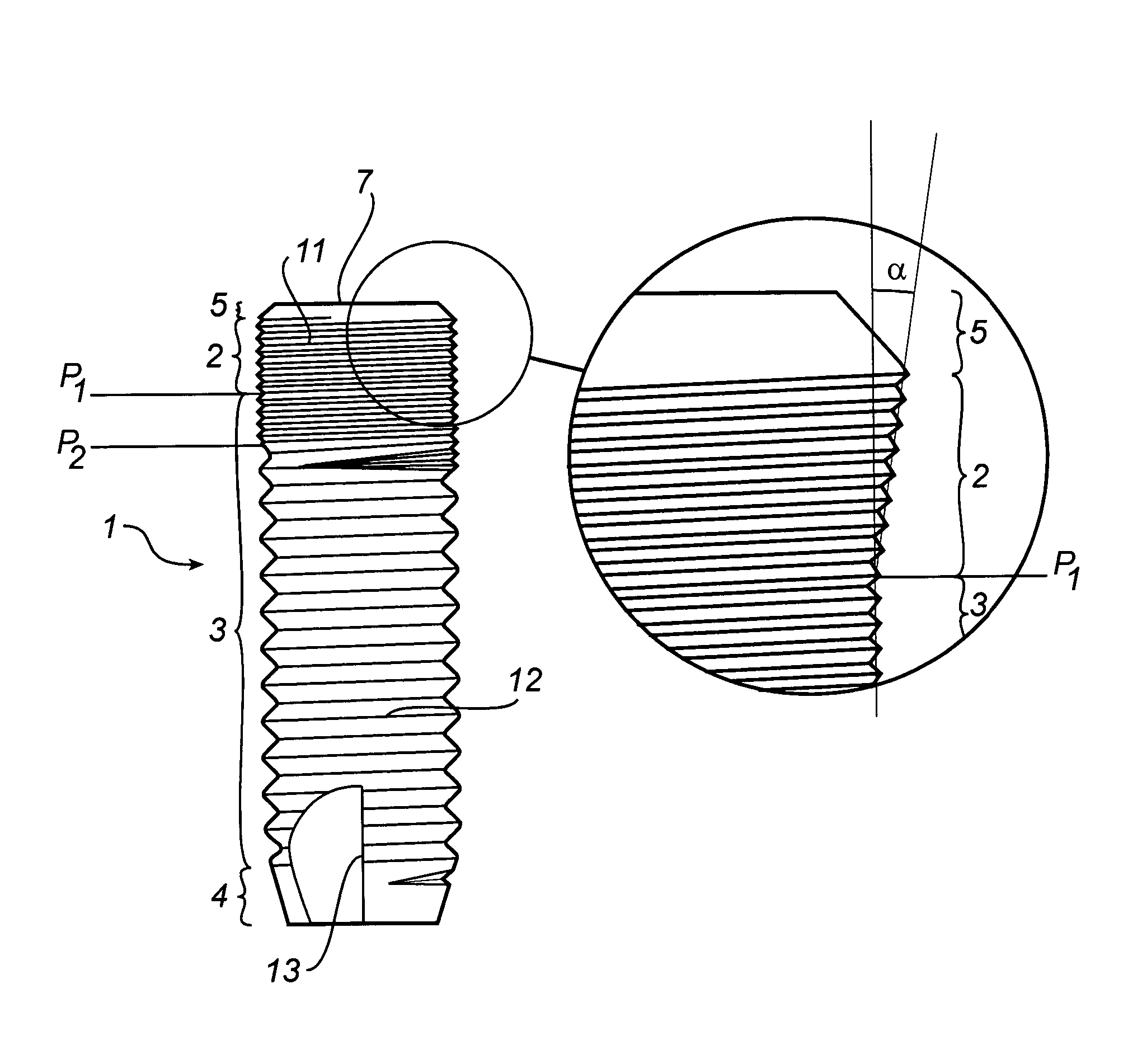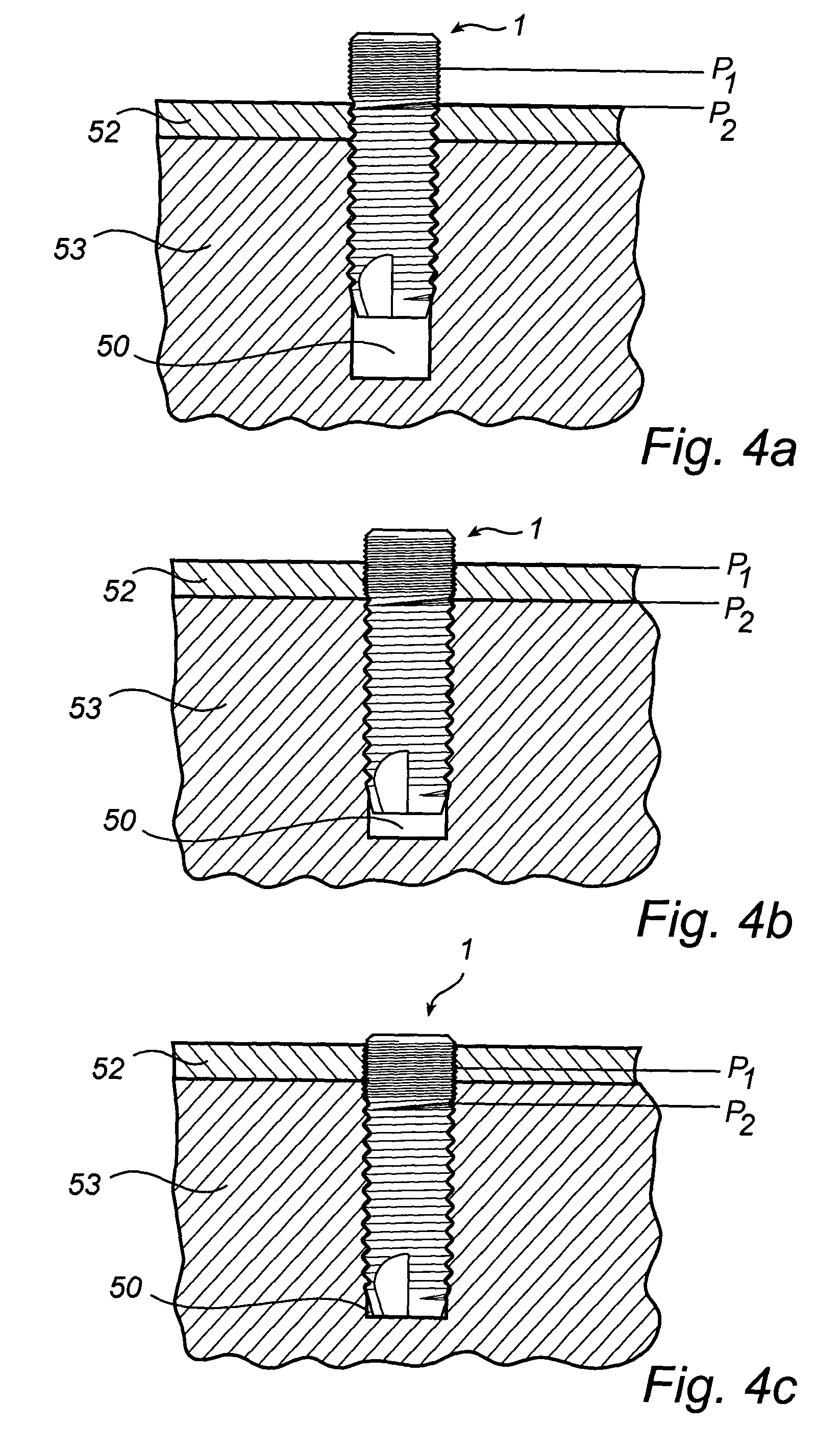Implant, arrangement comprising an implant, and method for inserting said implant in bone tissue
a technology of implant and bone tissue, which is applied in the field of screw implants, can solve the problems of bone resorption, secondary problems, and failure of the prosthesis, and achieve the effects of reducing the problem of thread damage, easy installation, and good functioning
- Summary
- Abstract
- Description
- Claims
- Application Information
AI Technical Summary
Benefits of technology
Problems solved by technology
Method used
Image
Examples
first embodiment
[0077]the invention will now be described in relation to FIGS. 1 to 3. This embodiment shows the inventive concept applied on the previously mentioned prior-art implant as is described in WO 00 / 03657 (Astra Aktiebolag, Hansson), where it is believed to have a particularly advantageous effect.
[0078]The implant 1 having a generally cylindrical shape is a dental implant for insertion into a bore hole drilled in the bone tissue of a maxilla or mandible, for anchorage of a prosthesis. The implant 1 is made from commercially pure titanium, a titanium alloy, another biocompatible metal or metal alloy or a ceramic to promote osseointegration of the implant with the bone tissue of the boundary walls of the bore hole.
[0079]The length of the implant 1 is preferably between 8-19 mm and the maximum width around 3-4 mm. The implant 1 depicted in FIGS. 1a to 3 has a length of 12 mm, and a width of 4 mm.
[0080]The implant has a cancellous portion 3 presenting a cylindrical outer surface, and a corti...
second embodiment
[0095]In FIGS. 5a and 5b the invention is shown. This implant is a variant of the implant described in connection to FIGS. 1 to 3. The implant depicted in FIGS. 5a and 5b differs from the implant of FIG. 1 in that only the cortical portion 2 is provided with microthreads, whereas all lower parts of the implant are provided with macrothreads. In other words, the border plane P2 between the first and second threadings 11 and 12 coincides with the border plane P1 between the cortical portion 2 and the cancellous portion 3.
[0096]The first threading 11 merges with the second threading 12 in the same manner as described in relation to the first embodiment. Thus, also in this embodiment the threaded outer surface of the cortical portion 2 engages in the same internal threads as the cancellous portion 3, facilitating the insertion of the cortical portion 2 in the bore hole.
third embodiment
[0097]In FIGS. 6a and 6b the invention is shown. This implant is yet another variant of the implant described in connection to FIGS. 1 to 3, differing from the implant in FIG. 1 in that there is only one threading 11 provided on the implant.
[0098]The threading 11 extends with no interruption over the tip portion 4, the cancellous portion 3, and the cortical portion 2. In this case, the threading 11 has a triple micro-thread. The micro-thread is believed to contribute to a favourable load distribution around the implant, in particular for inhibiting bone resorption.
PUM
 Login to View More
Login to View More Abstract
Description
Claims
Application Information
 Login to View More
Login to View More - R&D
- Intellectual Property
- Life Sciences
- Materials
- Tech Scout
- Unparalleled Data Quality
- Higher Quality Content
- 60% Fewer Hallucinations
Browse by: Latest US Patents, China's latest patents, Technical Efficacy Thesaurus, Application Domain, Technology Topic, Popular Technical Reports.
© 2025 PatSnap. All rights reserved.Legal|Privacy policy|Modern Slavery Act Transparency Statement|Sitemap|About US| Contact US: help@patsnap.com



